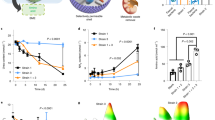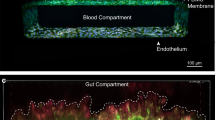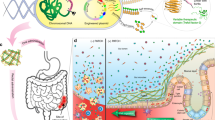Abstract
Safety concerns about introducing genetically engineered cells into the body have prevented their use in medical treatments. To solve this problem, we prepared polymeric membrane artificial cells (semipermeable microcapsules) containing genetically engineered live cells from the bacteria Escherichia coli DH5. When given orally, the cells remain at all times in the microcapsules and are finally excreted in the stool. During their passage through the intestine, small molecules like urea diffuse rapidly into the microcapsules and are acted on by the genetically engineered cells. This lowers the high plasma urea level to normal in uremic rats with induced kidney failure, and has exciting implications for the use of this and many other types of genetically engineered cells in a number of medical applications.
This is a preview of subscription content, access via your institution
Access options
Subscribe to this journal
Receive 12 print issues and online access
$209.00 per year
only $17.42 per issue
Buy this article
- Purchase on Springer Link
- Instant access to full article PDF
Prices may be subject to local taxes which are calculated during checkout
Similar content being viewed by others
References
Griffin, A.M. & Griffin, H.G., Preface. in Molecular Biology: Current Innovations and Future Trends, part 2. (eds. Griffin, A.M. & Griffin, H.G.) 5–6 (Horizon Scientific Press, Norfolk, England, 1995).
Mange, A.P. Genetic engineering snowballs. Biosdence 34, 642–643 (1984).
Chang, T.M.S. Semipermeable microcapsules. Science 146, 524–525 (1964).
Chang, T.M.S. Artificial cells. in Encyclopedia of Human Biology, vol. 1. (ed. Dulbecco, R.) 377–383 (Academic Press, San Diego, California, 1991).
Chang, T.M.S. Artificial cells with emphasis on bioencapsulation in biotechnology. Biotechnol. Annu. Rev. 1, 267–295 (1995).
Charles, S., David, M. & Stacia, M. Control of body fluid, electrolyte, and acid–base balance. in Human Physiology: Foundations and Frontiers. (ed. Deborah, A.) 526–527 (Times-Mirror College Publications, St. Louis, Missouri, 1990).
Asaba, H. et al. Plasma middle molecules in asymptomatic and sick uremic patients. in Middle Molecules in Uremia and Other Diseases. (ed. Klinkmann, H. et al.) 137–141 (International Society for Artificial Organs, Cleveland, Ohio, 1980).
Cohen, B.D. Uremic toxins. in Uremia, an International Conference on Pathogenesis, Diagnosis and Therapy. (eds. Kulte, R., Geoffrey, B. & Benjamin, B.C.) 1–11 (Thieme, Stuttgart, 1972).
Kolff, W.J. Artificial kidney and artificial heart: Future considerations. Int. J. Artif. Org. 13, 404–406 (1990).
Esposito, R., Carmelo, G. & G. Polyhalides. in Sorbents and their Clinical Applications, (ed. Caramelo, G.) 133–153 (Academic Press, London, 1980).
Kjellstrand, C., Borges, H., Pru, C., Gardner, D. & Fink, D. On the clinical use of microencapsulated zirconium phosphate-urease for the treatment of chronic uremia. Trans. Am. Soc. Artif. Intern. Org. 27, 24–30 (1981).
Drukker, W., Parsons, P.M. & Mahar, J.F. Replacement of Renal Functions by Dialysis. (Martinus Nijhoff, Boston, 1983).
Friedman, E.A. Future treatment of renal failure. in Strategy in Renal Failure, (ed. Friedman, E.A.) 521–528 (Wiley, New York, 1978).
Sparks, R.E., Saleman, R.M., Meier, P.M., Litt, M.H. & Lindon, O. Binders to remove metabolite from the GI tract. Tram. Am. Soc. Artif. Intern. Org. 18, 458–464 (1972).
Sparks, R.E. Review of gastrointestinal perfusion in treatment of uremia. Clin. Nephrol. 11, 81–85 (1979).
Walker, J.M., Jacobson, R.L., Stephen, W.J. & Rose, D. The role of adsorbents in the wearable artificial kidney. in Artificial Organs. (ed. Gilchrist, T.) 137–149 (Macmillan Press, London, 1977).
Gu, K.F. & Chang, T.M.S. Conversion of alpha-ketoglutarate into L-glutamic acid with urea as ammonia source using multienzyme system and NAD immobilized by microencapsulation with artificial cell in bioreactor. Biotechnol. Bioeng. 32, 363–368 (1988).
Gu, K.F. & Chang, T.M.S. Conversion of urea or ammonia into essential amino acids, L-leucine, L-valine and L-isoleucine using artificial cells containing an immobilized multienzyme system and dextran-NAD: Yeast alcohol dehydrogenase for enzyme recycling. J. Biotech. Appl Biochem. 12, 227–236 (1991).
Cattaneo, M. & Chang, T.M.S. The potential of microencapsulated urease-zeolite oral sorbent for the removal of urea in uremia. J. Am. Soc. Artif. Intern. Org. 37, 80–87 (1991).
Friedman, E.A., Fastcook, J., Beyer, M.M., Rattazzi, T. & Josephson, A.S. Combined oxystarch-charcoal trial in uremia, sorbent induced reduction in serum cholesterol. Kidney Int. 13, S273–S276 (1976).
Agishi, T., Yamashita, N. & Ota, K. Clinical results of direct charcoal hemoperfusion for endogenous and exogenous intoxication. in Hemoperfusion, Part I, Kidney and Liver Support and Detoxification (eds. Sidemen, S. & Chang, T.M.S.) 255–263 (Hemisphere, Washington, DC, 1980).
Prakash, S. & Chang, T.M.S. Microencapsulated genetically engineered E. coli cells containing genes from K. aerogens for urea and ammonia removal. Biomater. Artif. Cells Immobilization Biotechnol 19, 687–697 (1993).
Prakash, S. & Chang, T.M.S. Preparation and in vitro analysis of genetically engineered E. coli DH5 cells, microencapsulated in artificial cells for urea and ammonia removal. Biotechnol. Bioeng. 46, 621–626 (1995).
Chang, T.M.S. & Prakash, S. Artificial cells and genetically engineered microencapsulated E. coli cells, for urea and ammonia removal. in Methods in Molecular Biology, vol. 63, Expression and Detection of Recombinant Gene, Ch. 75 (ed. Tuan, R.S.) (Humana, Totowa, New Jersey, in the press).
Lim, F. & Sun, A.M. Microencapsulated islets as bioartificial pancreas. Science 210, 908–910 (1980).
Shian-Soon, P. et al. Insulin independence in a type 1 diabetic patient after encapsulated islet transplant. Lancet 343, 950–951 (1994).
Chang, T.M.S. Biotechnology of artificial cells including application to artificial organs. in Comprehensive Biotechnology: The Principle Applications & Regulation of Biotechnology in Industry, Agriculture, and Medicine, (ed. Young, M.M.) 53–73 (Pergamon, New York, 1985).
Goosen, A.M. & Mattheus, F.A. Research on animal cell culture in microcapsules. Chem. Eng. Educ. 22, 196–200 (1988).
Demetriou, A.A. & Whiting, J.F. Replacement of liver function in rats by transplantation of microcarriers-attached hepatocytes. Science 233, 1190–1192 (1986).
Demetriou, A.A. Hepatocyte transplantation. Sci. Am. Sci. Med. 1, 58–67 (1994).
Saarvedra, M.J., Baumann, N., Oung, I., Perman, J. & Yolken, R.H. Feeding of Bifidobacterium bifidum and Streptococcus thermophilus to infants in hospital for prevention of diarrhea and shedding of rotavirus. Lancet 344, 1046–1049 (1995).
Setala, K., Heinonen, H. & Schreck-Purla, I. Ingestion of lyophilized soil bacteria for alleviation of uremic symptoms. IRCS Med. Sci. Nephrol. Urol. 73 (10–97), 35 (1973).
Setala, K., Heinonen, H. & Schreck-Purla, I. Uremic waste recovery. Proc. Eur. Dial. Transplant Assoc. 9, 514–520 (1972).
Mobley, H.L. & Haussinger, R.P. Microbial ureases: Significance, regulation, and molecular characterization. Microbiol. Rev. 53, 85–108 (1989).
Scoot, B., Mulrooney, H., Stuart, P. & Haussinger, R.P. Regulation of gene expression and cellular localization of cloned K. aerogens urease . J. Gen. Microbiol. 135, 1769–1776(1989).
Sambrook, J., Fritsch, E.F. & Maniatis, T. T. Molecular Cloning: A Laboratory Manual, 2nd edn. (Cold Spring Harbor Laboratory Press, Cold Spring Harbor, New York, 1989).
Marincs, F. & White, D.W.R. Immobilization of E. coli expressing the lux gene of Xenorhabdus luminescence . Appl. Environ. Microbiol. 60, 3862–3863 (1994).
Symmour, A.C. & Philip, P.C. Colorimetric determination of carbamylamino acids and related compounds. J. Biol. Chem. 209, 145 (1954).
Author information
Authors and Affiliations
Rights and permissions
About this article
Cite this article
Prakash, S., Chang, T. Microencapsulated genetically engineered live E. coli DH5 cells administered orally to maintain normal plasma urea level in uremic rats. Nat Med 2, 883–887 (1996). https://doi.org/10.1038/nm0896-883
Received:
Accepted:
Issue Date:
DOI: https://doi.org/10.1038/nm0896-883
This article is cited by
-
Gut microbial metabolites SCFAs and chronic kidney disease
Journal of Translational Medicine (2024)
-
The gut microbiome tango in the progression of chronic kidney disease and potential therapeutic strategies
Journal of Translational Medicine (2023)
-
Evaluation of the effectiveness of two new strains of Lactobacillus on obesity-induced kidney diseases in BALB/c mice
Journal of Genetic Engineering and Biotechnology (2022)
-
Therapeutic Prospective of a Spore-Forming Probiotic—Bacillus clausii UBBC07 Against Acetaminophen-Induced Uremia in Rats
Probiotics and Antimicrobial Proteins (2020)
-
Effects of Probiotics on Inflammation and Uremic Toxins Among Patients on Dialysis: A Systematic Review and Meta-Analysis
Digestive Diseases and Sciences (2019)



